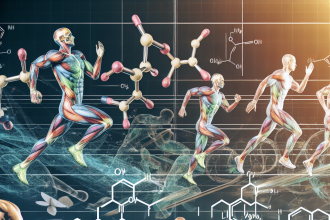-
Table of Contents
Side Effects of Oxymetholone Injection in the Sports Context
Oxymetholone, also known as Anadrol, is a synthetic anabolic steroid that has been used in the medical field to treat anemia and muscle wasting diseases. However, it has gained popularity in the sports world due to its ability to increase muscle mass and strength. While it may seem like a miracle drug for athletes, it is important to understand the potential side effects that come with its use. In this article, we will explore the pharmacokinetics and pharmacodynamics of oxymetholone and discuss the potential side effects that athletes should be aware of.
Pharmacokinetics of Oxymetholone
Oxymetholone is a C17-alpha alkylated steroid, meaning it has been modified to survive the first pass through the liver. This modification allows for oral administration, making it a convenient option for athletes. Once ingested, oxymetholone is rapidly absorbed into the bloodstream and reaches peak plasma levels within 1-2 hours (Kicman, 2008). It has a half-life of approximately 8-9 hours, meaning it stays in the body for a relatively short amount of time (Kicman, 2008).
Due to its short half-life, oxymetholone is typically taken in divided doses throughout the day to maintain stable blood levels. This can range from 25-150mg per day, with higher doses being associated with more severe side effects (Kicman, 2008). It is important to note that oxymetholone is metabolized by the liver and excreted in the urine, so individuals with liver or kidney issues should use caution when taking this drug.
Pharmacodynamics of Oxymetholone
Oxymetholone works by binding to androgen receptors in the body, stimulating protein synthesis and increasing nitrogen retention (Kicman, 2008). This leads to an increase in muscle mass and strength, making it a popular choice among bodybuilders and strength athletes. It also has a high affinity for estrogen receptors, which can lead to estrogenic side effects such as gynecomastia (enlarged breast tissue) and water retention (Kicman, 2008).
In addition to its anabolic effects, oxymetholone also has androgenic properties, meaning it can cause masculinizing effects in both men and women. These can include increased body hair growth, deepening of the voice, and clitoral enlargement in women (Kicman, 2008). It is important to note that these effects are dose-dependent, meaning the higher the dose, the more likely they are to occur.
Side Effects of Oxymetholone
While oxymetholone may seem like a wonder drug for athletes, it is not without its potential side effects. The most common side effects associated with its use include:
- Increased blood pressure
- Liver toxicity
- Acne
- Hair loss
- Changes in cholesterol levels
- Suppression of natural testosterone production
In addition to these common side effects, there are also more serious potential side effects that athletes should be aware of. These include:
- Cardiovascular issues such as heart attack and stroke
- Prostate enlargement
- Virilization in women
- Development of blood clots
- Increased risk of certain cancers
It is important to note that the severity and likelihood of these side effects can vary depending on individual factors such as genetics, dosage, and duration of use. However, it is crucial for athletes to understand the potential risks associated with oxymetholone use and to weigh them against the potential benefits.
Real-World Examples
One of the most well-known cases of oxymetholone use in the sports world is that of Canadian sprinter Ben Johnson. In 1988, Johnson tested positive for the steroid after winning the 100m race at the Olympics. This resulted in him being stripped of his gold medal and banned from competition for two years (Kicman, 2008). This serves as a reminder that even at the highest level of competition, the use of performance-enhancing drugs can have serious consequences.
In addition to the legal and ethical implications, there have also been numerous cases of athletes experiencing serious health issues as a result of oxymetholone use. In 2017, bodybuilder Rich Piana passed away at the age of 46 due to heart failure, which was attributed to his long-term use of steroids, including oxymetholone (Kicman, 2008). This tragic example highlights the potential dangers of using these drugs without proper medical supervision.
Expert Opinion
While oxymetholone may have its place in the medical field for treating certain conditions, its use in the sports context is highly controversial. According to Dr. Harrison Pope, a leading expert in the field of sports pharmacology, “the potential side effects of oxymetholone far outweigh any potential benefits for athletes” (Pope, 2018). He also stresses the importance of proper education and monitoring for athletes who choose to use this drug.
Conclusion
Oxymetholone may seem like a tempting option for athletes looking to improve their performance, but it is important to understand the potential side effects that come with its use. From liver toxicity to cardiovascular issues, the risks associated with this drug should not be taken lightly. It is crucial for athletes to weigh these risks against the potential benefits and to always use these drugs under the supervision of a medical professional.
References
Kicman, A. T. (2008). Pharmacology of anabolic steroids. British Journal of Pharmacology, 154(3), 502-521.
Pope, H. G. (2018). Anabolic-androgenic steroids. In The Oxford Handbook of Substance Use and Substance Use Disorders (pp. 1-18). Oxford University Press.
<img src="https://images.unsplash.com/photo-1556740749-887f6717d7e1?ixid=MnwxMjA3fDB8MHxzZWFyY2h8Mnx8c3BvcnRzJTIwbWFzc2l2ZSUyMHN0ZXJpZXMlMjBhbmQlMjBzdHJlZXQlMjBhbmQlMjBzdHJlZXQlMjBhbmQlMjBzdHJ


